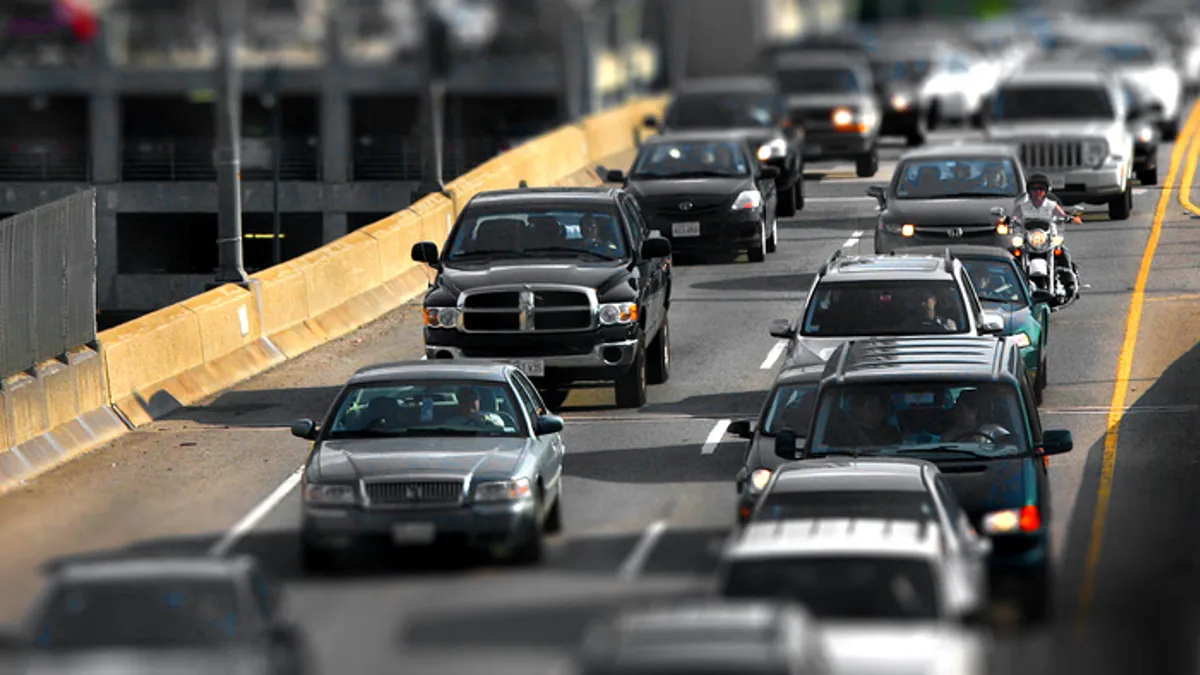Dive Brief:
- Los Angeles tops the list of the most gridlocked global cities for the sixth year, in an annual study by transportation analytics company Inrix. Los Angeles drivers spent an average of 102 hours in traffic during peak times last year.
- Other cities where drivers spend the highest amount of hours in traffic, on average, are: Moscow (91), New York (91), Sao Paolo (86), San Francisco (79), Bogota (75), London (74), Atlanta (70), Paris (69) and Miami (64). The company crunched the data from 1,360 cities in 38 countries.
- U.S. cities made up 10 of the top 25 global cities with the worst traffic, making it the world's most congested developed country.
Dive Insight:
Inrix gathered the data from 300 million connected cars and devices to calculate the average number of hours drivers spend in congestion each day. It found that the top five most congested countries in the world are Thailand (1), Indonesia (2), Colombia (3), Venezuela (4), Russia (5, tied) and the United States (5, tied). Analysts concluded that traffic congestion is a global problem that affects commuters, businesses and both small and large cities.
Looking only at the United States, the rest of the top 10 cities with the worst traffic besides those that made the global top 10 are Washington, D.C., Boston, Chicago, Seattle and Dallas. GeekWire points out that eight of the top 10 congested U.S. cities are vying for Amazon's HQ2, leaving out only San Francisco and Seattle. That's not surprising considering traffic tends to be far worse in big cities, and these are some of the biggest in the country. Amazon had specifically requested that applicants be large metropolitan areas of at least 1 million people.
Late last year Inrix had released another study showing that traffic congestion will cost U.S. commuters $295 billion in lost time, wasted fuel and carbon emitted over the next decade.
The new Inrix analysis has some of the same global cities on its top 25 most congested list as other companies' congestion studies, such as one by TomTom released last year. But a lot of the cities on the lists are far different. TomTom ranked Mexico City number one for congestion, and the first U.S. city to appear on that list is Los Angeles, at number 12.
A number of factors can contribute to these kind of discrepancies, but mainly it all comes back to varying methodologies. These are not scientific, peer-reviewed research studies, they are merely different companies' analyses of their own gathered data. Each company that produces one of these analyses could be using different data tracking devices and have a different number of devices in each city. For example, TomTom says its study is based on its own and its partners' GPS measurements, whereas Inrix gathers data from numerous sources that include GPS, cameras and mobile devices. Some would argue that a lack of control groups or uniform datasets for comparison across all types of the many available traffic congestion studies reduces their overall accuracy and validity in making sweeping statements about individual cities' rankings.
The cities under examination are also different in various analyses. For example, Inrix gathered data from 1,360 cities in 38 countries, whereas TomTom surveyed 390 cities in 48 countries. Although there is certainly overlap on some of those, these congestion studies and others clearly use different cities and sample sizes.
Despite the differences, one thing is evident across nearly all traffic congestion studies: Drivers in most cities consistently experience worsening traffic congestion and it's affecting urban mobility. It also affects residents' health, both from a mental and a physical perspective. And the economy takes a hit because of lost time and resources, not to mention economic dips if people avoid visiting businesses when they fear bad traffic along the way.
"If we’re to avoid traffic congestion becoming a further drain on our economy, we must invest in intelligent transportation systems to tackle our mobility challenges," said Dr. Graham Cookson, Chief Economist at Inrix, in a statement.












